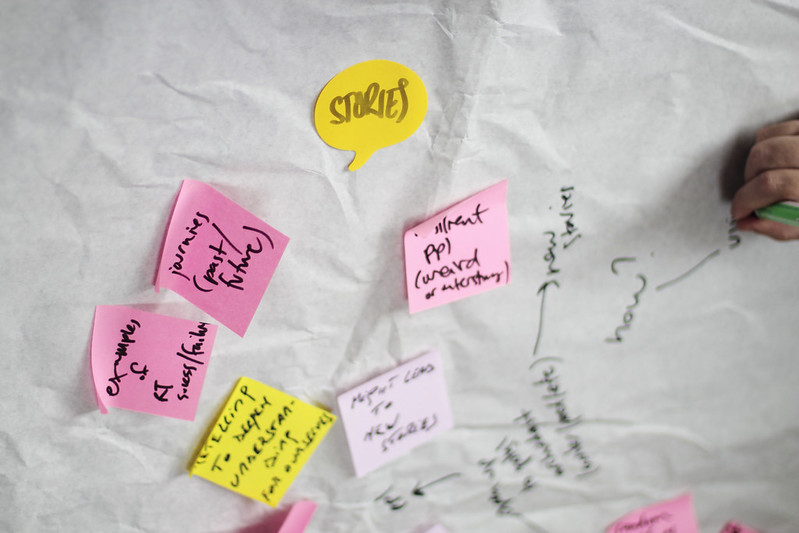Resilients in review: a diversity of practices
This page is an overview of the featured chronicles of the Resilients team. Resilients transform the concept of resilience into concrete practice as intentional voyages, experimental situations and real-life labs. Spanning several countries and numerous roads, paths, rivers, canals and gardens, the wide geographical spread of the Resilients' activities is mirrored in the diversity of their approaches. From biking, hiking and boating to growing, gardening and future-building – in all cases they seek to step beyond the bounds of theoretical debate to explore and embed cultural resilience in creative action.
In Words which Matter to People, Dougald Hine questions the concept of “resilience” itself – not through academic debate, but by talking to people on the streets of Helsinki about the Finnish word sisu. Comparing their visceral and culturally grounded use of this concept with the distant, etiolated notion of “resilience” as it is deployed in political, environmental and scientific discourse, he finds that the meaning we make or find in the world – embodied in such notions as sisu – is deeply bound up with our capacity to endure in turbulent times. Read more about Dougald’s travels as journeyman and artist in transience in his wide-ranging conversation with Shelbatra Jashari for the Resilients project.
Tim Boykett, Pippa Buchannan and a motley crew of enthusiastic DIY sailors embarked on an exploration of water rights and “luminous green” sailing in Control of the Commons. In Resilient Boating, Tim writes of sustainability, graceful decay, and the balance of effort versus utility in the realm of boat building and sailing, while Pippa recounts how a confessed food lover embraces the challenge of improvised gourmet cooking for several people on a tiny boat in The Resilient Aristologist. Each of their boating adventures is narrated in the Murray River Journey, the Danube Journey, and the Belgian Canals – as are the details of how they went about constructing the two vessels they sailed, the Subak1 and Subak2. Also check out some notes towards a manifesto of a DIY pirate.
Natalia Borissova explored augmented urban gardening through a series of living lab experiments with “non-green” mushrooms, finding in fungi an infinite source of inspiration for recycling and adaptation to changing environmental conditions. Her practical explorations in mushroom growing are documented in The Non Green (R)evolution, while Go Ask a Mushroom: musings on Afterculture advocates fungi and their mycelial roots as a source of continued inspiration for a resilient “life after culture.” At the same time, Dismas Leonard Sekibaha narrates his experiences at Time’s Up as “gardener in residence” – of both the green and non-green variety – in My Summer in an Urban Garden. nadine intervenes in the urban microcosm of hidden gardens in Wastl, an experiment in urban gardening techniques and community building.
Edible Alchemy by Carole Collet and Bartaku discusses resilience and adaptation in relation to the properties of two intriguing plants – flax and Aronia – and how these were used in Temporary photoElectric Digestopians (TpED), a series of co-creation worklabs, and the Edible Alchemy Aperolab. Resilience Thinking DIY was an exercise held at Central Saint Martin's College and is summarised here to encourage readers to practice resilient thinking in design. A Leaky Loop by Bartaku narrates the kind of intimate and bizarre experience you can expect as a TpED creator and tester, while Silients is a fragmentary meditation on a peculiar variation of “resilients.”
In The Pollinators, nadine review the meaning and implications of reviving modes of cultural travel where the journey is the destination, as an antidote both for tourism and the utilitarian obsession with getting from A to B in the shortest time and space. As journeys bring out the philosophers in all of us, one of the travellers, Carla Garlaschi used the trip to meditate on the important things in life in Las Cosas Importantes. In addition to the Pollinators/Peregrini trip, nadine explores other forms of “slow mobility” with the Buratinas solar-powered boat and tapping into participants' “creative DNA” through situationist interventions in Being Boucalais 1(i). Meanwhile, Theun Karelse compares and contrasts his experiences of biking and hiking on the Polliinators/Peregrini and Unmanned Resilience expeditions, and discusses several ideas for designing future modes of resilient travel, in Resilient Travel: From Biking to Hiking.
In Unmanned Aerial Ecologies, Honor Harger examines artistic interventions in the informational airspace ecology of drones – a pervasively military and government-centric frontier – and in particular the work by Marko Peljhan, who has been active in this area since the 90s. In connection with the Unmanned Resilience case study, Uroš Veber interviewed Helena Krapež, the owner of an excursion farm on the Gora plateau in western Slovenia. If you can’t pay for a loaf, go bake your own is a fascinating ethnographic glimpse into the state of farming in this region, and by extension, the changes and upheavals taking place in the wider society of Slovenia – not to mention the resourcefulness of one woman in challenging circumstances. Shelbatra Jashari narrates her journey in search of personal resilience during the Unmanned Resilience field trip and about meeting the Peregrini at the end of their journey in her poetic Surrender Travelogue.
Exploring methods of prototyping possible futures, Anna Maria Orru and David Relan discuss their scenario building toolkit in Composing a Scenario Symphony. This approach draws on a combination of Lance Gunderson and C. S. Holling’s panarchy systems model outlined in From Pan To Panarchy, and the idea of The Temporal Model in Future Scenario Building. Maja Kuzmanovic and Nik Gaffney build and reflect on these foundations in the Prehearsal Pocket Guide, a recipe for designing and enacting prehearsals, and Prehearsing the Future, a sustained examination and roundup of FoAM's own ventures in future preparedness. Finally, Christina Stadlbauer and FoAM explore contemplative and meditative techniques for cultivating “inner resilience” in Naikan as Resilient Practice.
